

Alice's Adventures in Wonderland by Lewis Carroll book review. What’s down the rabbit hole?
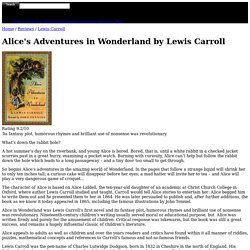
A hot summer’s day on the riverbank, and young Alice is bored. Bored, that is, until a white rabbit in a checked jacket scurries past in a great hurry, examining a pocket watch. Burning with curiosity, Alice can’t help but follow the rabbit down the hole which leads to a long passageway – and a tiny door too small to get through. So begins Alice’s adventures in the amazing world of Wonderland. In the pages that follow a strange liquid will shrink her to only ten inches tall; a curious cake will disappear before her eyes; a mad hatter will invite her to tea – and Alice will play a very dangerous game of croquet… The character of Alice is based on Alice Liddell, the ten-year-old daughter of an academic at Christ Church College in Oxford, where author Lewis Carroll studied and taught.
What is Alice in Wonderland Syndrome? Imagine you’re just drifting off to sleep when you suddenly realize that your hands have swollen to monstrous size, and the furniture in your bedroom has shrunk so small it could fit in a dollhouse.
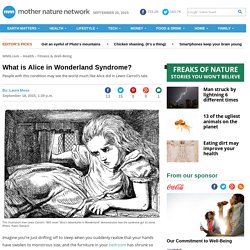
Such an occurrence may be impossible, but to the people with Alice in Wonderland Syndrome, who perceive these experiences of growing and shrinking, it’s very, very real. AIWS is a neurological condition that affects perception and typically occurs in children. Not much has been written about AIWS in peer-reviewed papers, but Dr. Grant Liu, a pediatric neuro-ophthalmologist who’s studied AIWS for years, says it’s likely more widespread than doctors expect.
“There are a lot of kids with this,” he told The Atlantic. People with AIWS typically experience some combination of macropsia (seeing things as too big), micropsia (seeing things as too small), pelopsia (seeing things closer to them) and teleopsia (seeing things farther from them). The Social and Political Contexts of the Alice Books. Alice in Wonderland's Dream Analysis. Lewis Carroll's famous story and one of Walt Disney's hit movies, Alice in Wonderland, is a story about a curious girl named Alice that dreams of having a "world of her own".
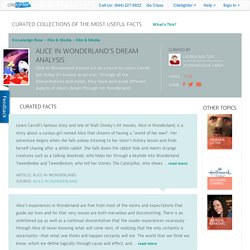
Her adventure begins when she falls asleep listening to her sister's history lesson and finds herself chasing after a white rabbit. She falls down the rabbit hole and meets strange creatures such as a talking doorknob, who helps her through a keyhole into Wonderland; Tweedledee and Tweedledum, who tell her stories; The Caterpillar, who shows … read moreher the mushroom to make her grow; and the Mad Hatter and the March Hare, who celebrate and unbirthday at their tea party. Finally, Alice has a run-in with the Queen of Hearts and her army of playing cards. Eventually, Alice is awakened from this nightmare by the recitations of her sister and the purring of her cat, Dinah. The release date of the movie was July 26, 1951. [^] Save Capture to Project. Alice's Adventures in Wonderland Analysis. River bank River bank.
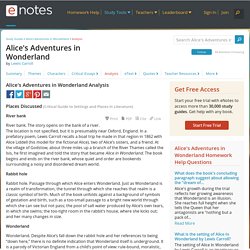
The story opens on the bank of a river. The location is not specified, but it is presumably near Oxford, England. Alice's Adventures in Wonderland. Alice's Adventures in Wonderland Alice's Adventures in Wonderland and its sequel Through the Looking-Glass, and What Alice Found There are written by Charles Lutwidge Dodgson, who is better known as Lewis Carroll.

Both literary works have been incorporated into the story of Lost in many episodes, such as "White Rabbit", "The Man Behind the Curtain", "Through the Looking Glass, Part 1", "Something Nice Back Home", and "Lighthouse". Alice's Adventures in Wonderland When "Jack and Locke discuss Jack's 'hallucination' Locke advises that he should pursue his father's elusive image, symbolically comparing it to the White Rabbit from Alice in Wonderland. Locke tells Jack to put it to rest, and consider the possibility that everything that is happening on the Island happens for a reason. Themes in Alice's Adventures in Wonderland. Analysis - Alice-in-Wonderland.net. The Alice books have always been a favourite subject for analysis, as the story lends itself to various interpretations.
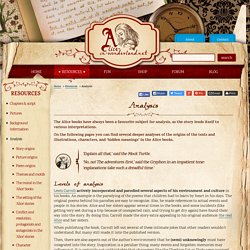
On the following pages you can find several deeper analyses of the origins of the texts and illustrations, characters, and ‘hidden meanings’ in the Alice books. ‘Explain all that,’ said the Mock Turtle. ‘No, no! The adventures first,’ said the Gryphon in an impatient tone: ‘explanations take such a dreadful time.’ Levels of analysis Lewis Carroll actively incorporated and parodied several aspects of his environment and culture in his books. When publishing the book, Carroll left out several of these intimate jokes that other readers wouldn’t understand. Then, there are also aspects out of the author’s environment that he (semi) unknowingly must have integrated into the story. Alice’s Adventures in Wonderland: Themes, Motifs & Symbols. Themes Themes are the fundamental and often universal ideas explored in a literary work.
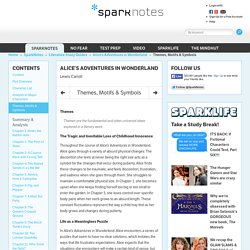
The Tragic and Inevitable Loss of Childhood Innocence Throughout the course of Alice’s Adventures in Wonderland, Alice goes through a variety of absurd physical changes. The discomfort she feels at never being the right size acts as a symbol for the changes that occur during puberty. Alice finds these changes to be traumatic, and feels discomfort, frustration, and sadness when she goes through them. Life as a Meaningless Puzzle. Alice's Adventures in Wonderland and Through the Looking-Glass Analysis.